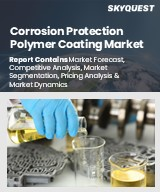
|
시장보고서
상품코드
1831571
케이블 방화 피복 시장 규모, 점유율, 성장 분석 : 제품 유형별, 용도별, 최종 이용 산업별, 배합별, 유통 경로별, 지역별 - 산업 예측(2025-2032년)Firestop Cable Coating Market Size, Share, and Growth Analysis, By Product Type (Intumescent Coatings, Cementitious Coatings), By Application, By End-use Industry, By Formulation, By Distribution Channel, By Region - Industry Forecast 2025-2032 |
||||||
세계 케이블 방화 피복 시장 규모는 2023년에 119억 달러로 평가되었으며, 예측 기간(2025-2032년) 동안 CAGR 5.7%로, 2024년 125억 8,000만 달러에서 2032년에는 196억 달러로 성장할 전망입니다.
세계 케이블 방화 피복 시장은 화재 안전에 대한 관심 증가, 엄격한 규제, 지속적인 인프라 개발로 인해 성장할 것으로 예상됩니다. 이러한 코팅제에 대한 수요는 각국 정부 및 규제 기관의 엄격한 화재 안전 기준의 영향을 크게 받고 있습니다. 도시화와 인구 증가는 인프라 투자의 대폭적인 증가와 함께 시장 전망을 더욱 향상시킬 것으로 예상됩니다. 산업 부문, 특히 석유 및 가스, 발전 및 제조 산업은 상당한 화재 위험에 직면해 있어 화재 위험에 대한 인식이 높아지면서 효과적인 화재 방지 솔루션에 대한 수요가 증가하고 있습니다. 또한, 지속가능성 트렌드는 친환경, 저 VOC, 할로겐 프리 제품에 대한 선호를 유도하고 있습니다. 하지만 높은 설치 비용, 신흥 시장에서의 낮은 인지도, 대체 재료의 존재 등의 문제는 시장 확대에 걸림돌이 될 수 있습니다.
자주 묻는 질문
목차
소개
- 조사 목적
- 조사 범위
- 정의
조사 방법
- 정보 조달
- 2차와 1차 데이터 방법
- 시장 규모 예측
- 시장 가정과 제한
주요 요약
- 세계 시장 전망
- 공급과 수요 동향 분석
- 부문별 기회 분석
시장 역학과 전망
- 시장 개요
- 시장 규모
- 시장 역학
- 성장 촉진요인과 기회
- 성장 억제요인과 과제
- Porters 분석
주요 시장 인사이트
- 핵심성공요인
- 경쟁 정도
- 주요 투자 기회
- 시장 생태계
- 시장 매력 지수(2024년)
- PESTEL 분석
- 거시경제 지표
- 밸류체인 분석
- 가격 분석
케이블 방화 피복 시장 규모 : 제품 유형별 & CAGR(2025-2032년)
- 시장 개요
- 팽창성 페인트
- 시멘트계 코팅
- 불연성 코팅
- 에폭시 코팅
케이블 방화 피복 시장 규모 : 용도별 & CAGR(2025-2032년)
- 시장 개요
- 패시브 방화
- 액티브 방화
케이블 방화 피복 시장 규모 : 최종 이용 산업별 & CAGR(2025-2032년)
- 시장 개요
- 건설
- 석유 및 가스
- 해양
- 교통기관
- 항공우주
케이블 방화 피복 시장 규모 : 처방별 & CAGR(2025-2032년)
- 시장 개요
- 수성 코팅
- 용제형 코팅
- 하이브리드 코팅
케이블 방화 피복 시장 규모 : 유통 채널별 & CAGR(2025-2032년)
- 시장 개요
- 직접 판매
- 판매대리점
- 온라인 판매
케이블 방화 피복 시장 규모 & CAGR(2025-2032년)
- 북미
- 미국
- 캐나다
- 유럽
- 독일
- 스페인
- 프랑스
- 영국
- 이탈리아
- 기타 유럽
- 아시아태평양
- 중국
- 인도
- 일본
- 한국
- 기타 아시아태평양
- 라틴아메리카
- 브라질
- 기타 라틴아메리카
- 중동 및 아프리카
- GCC 국가
- 남아프리카공화국
- 기타 중동 및 아프리카
경쟁 정보
- 상위 5개사의 비교
- 주요 기업의 시장 포지셔닝(2024년)
- 주요 시장 기업이 채용한 전략
- 최근의 시장 동향
- 기업의 시장 점유율 분석(2024년)
- 주요 기업 개요
- 기업 상세
- 제품 포트폴리오 분석
- 기업 부문별 점유율 분석
- 매출 전년비 비교(2022-2024년)
주요 기업 개요
- 3M Company(USA)
- Hilti Corporation(Liechtenstein)
- Sika AG(Switzerland)
- Akzo Nobel N.V.(Netherlands)
- BASF SE(Germany)
- The Sherwin-Williams Company(USA)
- Jotun A/S(Norway)
- Hempel A/S(Denmark)
- Specified Technologies Inc.(STI)(USA)
- Morgan Advanced Materials(UK)
- Promat International(Belgium)
- H.B. Fuller Company(USA)
- RectorSeal(USA)
- Fosroc International(UK)
- Rudolf Hensel GmbH(Germany)
- Contego International, Inc.(USA)
- Fire Security AS(Norway)
- Pyro-Cote(USA)
- Tremco Incorporated(USA)
- Nippon Paint Holdings Co., Ltd.(Japan)
결론과 제안
KSM 25.10.15Global Firestop Cable Coating Market size was valued at USD 11.9 billion in 2023 and is poised to grow from USD 12.58 billion in 2024 to USD 19.6 billion by 2032, growing at a CAGR of 5.7% during the forecast period (2025-2032).
The global firestop cable coating market is poised for growth driven by increasing fire safety concerns, stringent regulations, and ongoing infrastructure development. The demand for these coatings is significantly influenced by strict fire safety standards enforced by governments and regulatory bodies worldwide. Urbanization and population growth, coupled with substantial infrastructure investments, are expected to further enhance market prospects. Industrial sectors, particularly oil & gas, power generation, and manufacturing, face considerable fire risks, leading to heightened awareness of fire hazards and subsequent demand for effective firestop solutions. Additionally, sustainability trends are steering preferences towards eco-friendly, low-VOC, and halogen-free products. Nevertheless, challenges such as high installation costs, limited awareness in emerging markets, and the presence of alternative materials may hinder market expansion.
Top-down and bottom-up approaches were used to estimate and validate the size of the Global Firestop Cable Coating market and to estimate the size of various other dependent submarkets. The research methodology used to estimate the market size includes the following details: The key players in the market were identified through secondary research, and their market shares in the respective regions were determined through primary and secondary research. This entire procedure includes the study of the annual and financial reports of the top market players and extensive interviews for key insights from industry leaders such as CEOs, VPs, directors, and marketing executives. All percentage shares split, and breakdowns were determined using secondary sources and verified through Primary sources. All possible parameters that affect the markets covered in this research study have been accounted for, viewed in extensive detail, verified through primary research, and analyzed to get the final quantitative and qualitative data.
Global Firestop Cable Coating Market Segments Analysis
Global Firestop Cable Coating Market is segmented by Product Type, Application, End-use Industry, Formulation, Distribution Channel and region. Based on Product Type, the market is segmented into Intumescent Coatings, Cementitious Coatings, Non-Combustible Coatings and Epoxy Coatings. Based on Application, the market is segmented into Passive Fire Protection and Active Fire Protection. Based on End-use Industry, the market is segmented into Construction, Oil and Gas, Marine, Transportation and Aerospace. Based on Formulation, the market is segmented into Water-Based Coatings, Solvent-Based Coatings and Hybrid Coatings. Based on Distribution Channel, the market is segmented into Direct Sales, Distributors and Online Sales. Based on region, the market is segmented into North America, Europe, Asia Pacific, Latin America and Middle East & Africa.
Driver of the Global Firestop Cable Coating Market
One of the key market drivers for the global firestop cable coating market is the increasing emphasis on safety and compliance with stringent fire protection regulations across various industries, including construction, oil and gas, and manufacturing. As organizations prioritize the safety of their infrastructure and personnel, the demand for advanced fire safety solutions, such as firestop cable coatings, is escalating. These coatings not only enhance the fire resistance of electrical and communication cables but also help in minimizing fire hazards, thereby meeting regulatory standards and improving overall safety ratings. This heightened awareness and regulatory enforcement are fostering market growth.
Restraints in the Global Firestop Cable Coating Market
A key market restraint for the global firestop cable coating market is the stringent regulatory landscape surrounding fire safety standards. As various jurisdictions implement and enforce increasingly rigorous building codes and fire safety regulations, manufacturers may face challenges in ensuring compliance with these requirements, which can prolong the product development cycle and increase costs. Additionally, the need for ongoing testing and certification to meet these standards can restrict market entry for smaller players, limiting competition and innovation. This regulatory environment can deter investment and slow market growth, particularly in regions with less established fire safety frameworks.
Market Trends of the Global Firestop Cable Coating Market
The Global Firestop Cable Coating market is experiencing a substantial shift towards the adoption of intumescent and advanced polymer-based coatings, driven by increasing safety regulations and heightened awareness of fire hazards. Intumescent coatings are particularly favored for their ability to form an insulating barrier upon exposure to high temperatures, effectively inhibiting flame spread and ensuring the protection of critical cabling infrastructure. This trend reflects a broader move away from conventional firestop solutions, as industries seek innovative materials that enhance fire safety while offering improved performance and reliability. Consequently, manufacturers are focusing on the development of advanced formulations to cater to this growing demand.
Table of Contents
Introduction
- Objectives of the Study
- Scope of the Report
- Definitions
Research Methodology
- Information Procurement
- Secondary & Primary Data Methods
- Market Size Estimation
- Market Assumptions & Limitations
Executive Summary
- Global Market Outlook
- Supply & Demand Trend Analysis
- Segmental Opportunity Analysis
Market Dynamics & Outlook
- Market Overview
- Market Size
- Market Dynamics
- Drivers & Opportunities
- Restraints & Challenges
- Porters Analysis
- Competitive rivalry
- Threat of substitute
- Bargaining power of buyers
- Threat of new entrants
- Bargaining power of suppliers
Key Market Insights
- Key Success Factors
- Degree of Competition
- Top Investment Pockets
- Market Ecosystem
- Market Attractiveness Index, 2024
- PESTEL Analysis
- Macro-Economic Indicators
- Value Chain Analysis
- Pricing Analysis
Global Firestop Cable Coating Market Size by Product Type & CAGR (2025-2032)
- Market Overview
- Intumescent Coatings
- Cementitious Coatings
- Non-Combustible Coatings
- Epoxy Coatings
Global Firestop Cable Coating Market Size by Application & CAGR (2025-2032)
- Market Overview
- Passive Fire Protection
- Active Fire Protection
Global Firestop Cable Coating Market Size by End-use Industry & CAGR (2025-2032)
- Market Overview
- Construction
- Oil and Gas
- Marine
- Transportation
- Aerospace
Global Firestop Cable Coating Market Size by Formulation & CAGR (2025-2032)
- Market Overview
- Water-Based Coatings
- Solvent-Based Coatings
- Hybrid Coatings
Global Firestop Cable Coating Market Size by Distribution Channel & CAGR (2025-2032)
- Market Overview
- Direct Sales
- Distributors
- Online Sales
Global Firestop Cable Coating Market Size & CAGR (2025-2032)
- North America (Product Type, Application, End-use Industry, Formulation, Distribution Channel)
- US
- Canada
- Europe (Product Type, Application, End-use Industry, Formulation, Distribution Channel)
- Germany
- Spain
- France
- UK
- Italy
- Rest of Europe
- Asia Pacific (Product Type, Application, End-use Industry, Formulation, Distribution Channel)
- China
- India
- Japan
- South Korea
- Rest of Asia-Pacific
- Latin America (Product Type, Application, End-use Industry, Formulation, Distribution Channel)
- Brazil
- Rest of Latin America
- Middle East & Africa (Product Type, Application, End-use Industry, Formulation, Distribution Channel)
- GCC Countries
- South Africa
- Rest of Middle East & Africa
Competitive Intelligence
- Top 5 Player Comparison
- Market Positioning of Key Players, 2024
- Strategies Adopted by Key Market Players
- Recent Developments in the Market
- Company Market Share Analysis, 2024
- Company Profiles of All Key Players
- Company Details
- Product Portfolio Analysis
- Company's Segmental Share Analysis
- Revenue Y-O-Y Comparison (2022-2024)
Key Company Profiles
- 3M Company (USA)
- Company Overview
- Business Segment Overview
- Financial Updates
- Key Developments
- Hilti Corporation (Liechtenstein)
- Company Overview
- Business Segment Overview
- Financial Updates
- Key Developments
- Sika AG (Switzerland)
- Company Overview
- Business Segment Overview
- Financial Updates
- Key Developments
- Akzo Nobel N.V. (Netherlands)
- Company Overview
- Business Segment Overview
- Financial Updates
- Key Developments
- BASF SE (Germany)
- Company Overview
- Business Segment Overview
- Financial Updates
- Key Developments
- The Sherwin-Williams Company (USA)
- Company Overview
- Business Segment Overview
- Financial Updates
- Key Developments
- Jotun A/S (Norway)
- Company Overview
- Business Segment Overview
- Financial Updates
- Key Developments
- Hempel A/S (Denmark)
- Company Overview
- Business Segment Overview
- Financial Updates
- Key Developments
- Specified Technologies Inc. (STI) (USA)
- Company Overview
- Business Segment Overview
- Financial Updates
- Key Developments
- Morgan Advanced Materials (UK)
- Company Overview
- Business Segment Overview
- Financial Updates
- Key Developments
- Promat International (Belgium)
- Company Overview
- Business Segment Overview
- Financial Updates
- Key Developments
- H.B. Fuller Company (USA)
- Company Overview
- Business Segment Overview
- Financial Updates
- Key Developments
- RectorSeal (USA)
- Company Overview
- Business Segment Overview
- Financial Updates
- Key Developments
- Fosroc International (UK)
- Company Overview
- Business Segment Overview
- Financial Updates
- Key Developments
- Rudolf Hensel GmbH (Germany)
- Company Overview
- Business Segment Overview
- Financial Updates
- Key Developments
- Contego International, Inc. (USA)
- Company Overview
- Business Segment Overview
- Financial Updates
- Key Developments
- Fire Security AS (Norway)
- Company Overview
- Business Segment Overview
- Financial Updates
- Key Developments
- Pyro-Cote (USA)
- Company Overview
- Business Segment Overview
- Financial Updates
- Key Developments
- Tremco Incorporated (USA)
- Company Overview
- Business Segment Overview
- Financial Updates
- Key Developments
- Nippon Paint Holdings Co., Ltd. (Japan)
- Company Overview
- Business Segment Overview
- Financial Updates
- Key Developments



















